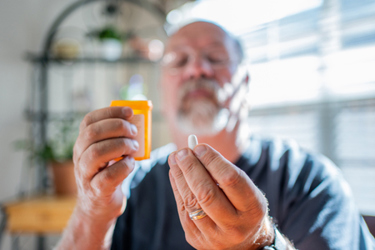Proximity To Patients Helps Unicycive Reduce Pill Burden
A conversation with Shalabh Gupta, MD, founder and CEO, Unicycive Therapeutics

Patient-centric clinical trials place the lived experience of patients at the center of drug development, ensuring that therapies not only demonstrate efficacy but also meaningfully fit into patients’ daily lives.
For its part, Unicycive Therapeutics directly solicits patient input through structured questionnaires, trial site partnerships, and open communication to help guide its intention to reduce treatment burden and improve quality of life.
In this Q&A, Unicycive CEO Shalabh Gupta, MD, shares how the company integrates patient feedback into the design of its trials, from addressing the overwhelming pill burden of dialysis patients to building trust through long-standing care relationships.
Clinical Leader: Designing trials to reflect and respect the patient experience is a tenet of patient-centric trials. How does Unicycive solicit patient input, and how is it used to design trials that meet patient needs?
Shalabh Gupta, MD: The patients and physicians have been central to our core mission of developing drugs that make a meaningful difference in patients’ lives. We have conducted three clinical trials, two clinical trials to advance oxylanthanum carbonate (OLC) and the third clinical trial (Phase 1) for UNI-494.
For OLC clinical trials, the most recent trial included approximately 86 patients who received the drug and were then evaluated not only for their serum phosphate levels but also for their ability to tolerate the drug and their own reported outcomes.
One of the key challenges that these patients face is the number of pills they have to take per day. On average, they are taking 12 to 15 pills per day to manage their phosphate and, on top of that, they take another 12 to 15 pills per day for other ailments. All in all, most of these patients are taking on an average of 20 to 30 pills per day, where half of their pill burden comes from the treatment of hyperphosphatemia.
Some of the key metrics we evaluated included their preference for taking three small pills per day, which can help the majority of patients achieve their target serum phosphate goals. We also assessed how they tolerated our drug and whether they felt better on it compared to previous medications they were taking.
We collected patient feedback through structured questionnaires administered throughout the clinical trial, which measured ease of use, satisfaction, and overall experience with OLC. The results showed that 98% of patients reported that OLC was easy to take, and 89% said they were satisfied with it as a treatment for hyperphosphatemia. From the start, we intentionally designed OLC to reduce pill burden while maintaining efficacy, knowing that patients with chronic kidney disease often face 10 to 20 pills a day. Fewer pills can make treatment less overwhelming, improve adherence, and ultimately enhance quality of life, which was a core focus in developing OLC’s formulation.
Why, when it comes to administration, might OLC present a better experience and better outcomes?
The three most significant challenges for patients who are taking medications for managing their phosphate levels and are on dialysis are: 1. a large number of pills; 2. if it is not a large number of pills, but relatively fewer pills, these fewer pills are large in size; and 3. these large pills have to be chewed. These pills taste really bad because they have metal in them, so essentially, patients are being asked to chew metal, and it tastes awful.
OLC offers advantages in all these fronts. OLC, if approved, can provide target serum phosphate levels for patients by taking one small pill with each meal that can be swallowed; it does not need to be chewed and dissolves with no taste within a few seconds in the mouth.
In addition to developing drugs that are easy for patients to take, you’re also looking to build patient trust as a means of driving recruitment and enrollment. How have Unicycive and its partners attempted to earn the trust of their patient population?
All of our trial centers were where patients have been going to dialysis clinics for years. We recruited patients from seven centers, and in all these centers, the healthcare professionals had long-standing relationships with these patients.
In the dialysis world, patients naturally build long-term, high-trust relationships with their care teams because they spend 4 to 6 hours per session, three times a week, in these clinics. When physicians and care teams introduce a new investigational drug with genuine enthusiasm, patients are far more likely to feel confident and engaged in participating in clinical trials. We also made the experience more tangible by sending physical plaques of our drug alongside existing treatments, so patients could see and compare how OLC looked and felt. That transparency, combined with trusted relationships and clear communication, went a long way in creating comfort, enthusiasm, and trust around trial participation.
Finally, what are the other tenets of a patient-centric model? And how does that differ from and prove better than existing models, such as site-centric models?
A patient-centric approach goes above and beyond clinical trials and recruitment, focusing on holistic experience and care for patients. Since the very beginning of our company, as a founder, I have always focused on the issues that can help patients and make their experience and overall care better. As a former practicing physician for over a decade, I saw firsthand that it is not always the fanciest inventions that truly help patients, but it is those solutions that truly solve their real problems. Patients who are on dialysis already have other medical comorbidities like diabetes, hypertension, coronary artery disease, etc., so requiring them to take 12 to 15 pills per day for a disease that is not immediately symptomatic does not make sense. Our drug, OLC, if approved, can address a huge unmet need.
About The Expert:
 Shalabh Gupta, MD, is a physician by training and the founder of three biotech companies. He built his latest company, Unicycive, from the ground up, with no funding or assets. When he took the company public on Nasdaq, it had only one full-time employee: himself. Dr. Gupta firmly believes that his achievements are made possible through the support of friends, mentors, and countless individuals who have been a part of his journey, both directly and indirectly.
Shalabh Gupta, MD, is a physician by training and the founder of three biotech companies. He built his latest company, Unicycive, from the ground up, with no funding or assets. When he took the company public on Nasdaq, it had only one full-time employee: himself. Dr. Gupta firmly believes that his achievements are made possible through the support of friends, mentors, and countless individuals who have been a part of his journey, both directly and indirectly.
